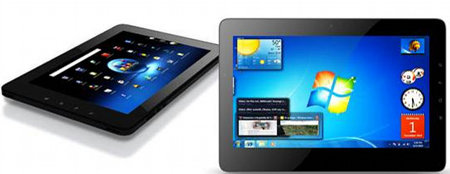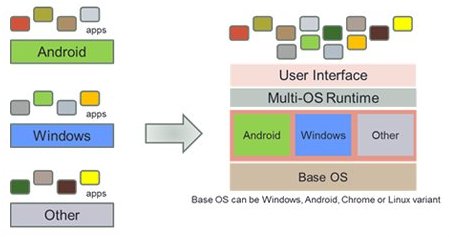Startup unveils way for Windows devices to run Android apps
May 25, 2011 — by LinuxDevices Staff — from the LinuxDevices Archive — viewsA new startup says it will soon offer software allowing Windows devices to run Android software. The eponymous “BlueStacks” — to be offered first on a ViewSonic tablet — permits launching Android apps directly from the Windows desktop, the company says.
Privately held BlueStacks "emerged from stealth mode" today, announcing that it has received $7.6 million in funding from five venture capital firms. The company is led by CEO Rosen Sharma, described as "a serial entrepreneur and most recently SVP and CTO of Innovation at McAfee."
The company claims its "groundbreaking technology … will allow users to seamlessly run Android and Windows applications on their x86-based devices." It's promised BlueStacks software will be soon be bundled by leading manufacturers of Windows tablets, notebooks, and desktops.

Currently offered in a dual-boot version, ViewSonic's ViewPad 10Pro will be supplied with BlueStacks technology in the third quarter
(Click to enlarge)
Of course, it's already possible to run Android applications on x86 devices, provided that their manufacturers have supplied a port of Google's Linux-plus-Java operating system. But thusly equipped products (such as the ViewSonic ViewPad 10Pro pictured above) have required users to select either Windows or Android at boot time, making a switch from one environment to another a lengthy process.
According to BlueStacks, its software takes a different tack, using Windows 7 as a host operating system and then providing Android on top of it. From within Windows, users can switch to a full Android desktop, or simply install Android app icons directly on the Windows desktop.
Unlike in a dual-boot configuration, Android apps are available from Windows in under one second, BlueStacks says. Data created in the Windows environment — pictures, documents, and music files, for example — is available to Android apps seamlessly, as are USB peripherals, the company further promises.
"As is the case with any advanced technology, the complexity is completely masked from the end consumer," the company says. But, it explains, BlueStacks actually "employs a lightweight, optimized, soft hypervisor with deep enhancements to support 'embedded virtualization'."

BlueStacks architecture
While the first iteration of BlueStacks uses x86 Windows as the host (boot) operating system, it's promised "the BlueStacks virtualization technology can very easily support different permutations and combinations of operating systems and their applications." According to the company, future versions will:
- allow running Android apps on future ARM-based versions of Windows ("Windows 8")
- run Android apps in a browser tab on the lightweight Chrome OS
- allow booting into an x86 version of Android "for faster startup and longer battery life," then run Windows applications when required
Consumer- and enterprise-friendly features
BlueStacks did not say which version of Android its product will initially be supplied with, but it claims users will be able to "upgrade Android to the latest version with automatic over-the-air updates." The company adds that BlueStacks "makes it very easy to find, download, and install Android apps," thanks to support for Amazon, GetJar, and SlideMe app stores.
Meanwhile, it's said BlueStacks will facilitate enterprise adoption of Android apps two different ways. First, all data can be stored in the Windows environment "where it can be encrypted and stored securely with the enterprise policies applied to it." Second, Android .APK application packages can be converted into the Windows .MSI format, then distributed and managed with Microsoft Systems Center or Citrix Receiver.
Availability
According to BlueStacks, its first Android-on-Windows version of the software is still undergoing invitation-only alpha testing. But the company claims the product — to be offered initially on the ViewSonic ViewPad 10 Pro tablet mentioned earlier in this story — will be available during the third quarter of 2011.
More information may be found on the BlueStacks website.
Meanwhile, those wishing to experiment with Android on Linux, Windows, or Macintosh OSX hosts via existing hypervisors — including VirtualBox or VMWare — can download a relevant .ISO boot image from the Android-x86 Project website.
Jonathan Angel can be reached at [email protected] and followed at www.twitter.com/gadgetsense.
This article was originally published on LinuxDevices.com and has been donated to the open source community by QuinStreet Inc. Please visit LinuxToday.com for up-to-date news and articles about Linux and open source.